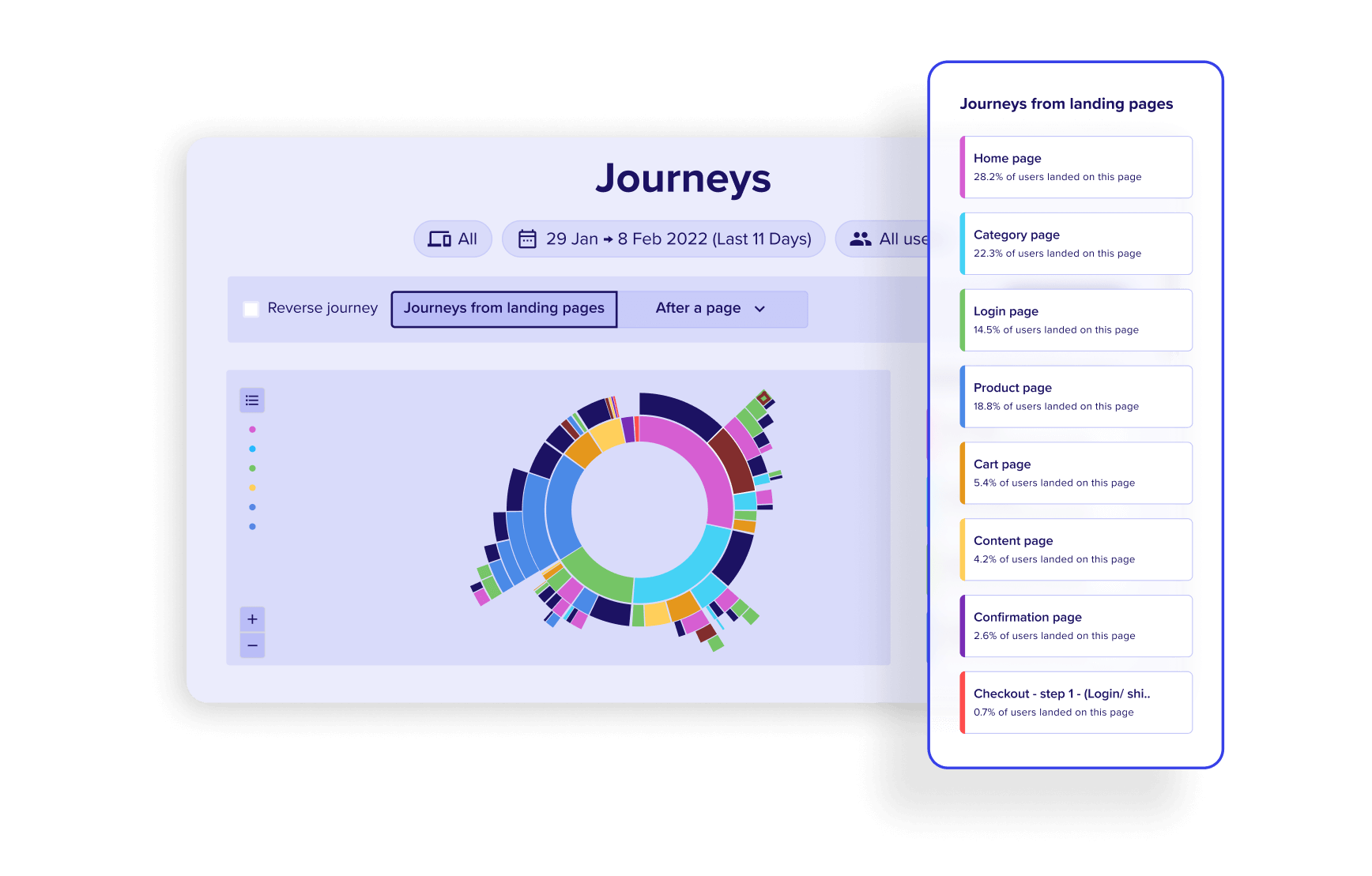
Intuitive visualizations of your customers journey.

UX Analytics Tools are robust software applications designed to perform an in-depth analysis of user experience (UX) on digital platforms. These tools are instrumental in capturing user behavior data, which is pivotal in understanding how users interact with a website or an application. They provide a comprehensive understanding of interaction design, tracking metrics such as session duration, bounce rate, click-through rate, and conversion rate. By analyzing these metrics, businesses can gain actionable insights about their website optimization efforts and make necessary improvements.
These tools offer a range of features for comprehensive UX analysis. Heatmaps, for example, are a form of data visualization that demonstrates user clicks, scrolls, and mouse movements, helping interaction designers identify popular areas and elements on a webpage. Session recordings offer a real-time view of user interactions, revealing potential usability issues. A/B testing features enable the comparison of different UX designs to ascertain which is more effective, thereby assisting in website optimization. UX Analytics Tools operate by tracking and analyzing user interactions with a website or app. They collect data on various metrics such as session duration, bounce rate, click-through rate, and conversion rate.
By examining these metrics, UX professionals can gain a deeper understanding of how users interact with a platform, what features they engage with, and where they encounter difficulties. This data-driven approach allows for more informed decision-making and targeted UX improvements.
In the digital marketing landscape, UX Analytics Tools are essential.
They provide empirical evidence of user behavior, enabling businesses to make data-driven decisions. With a deeper understanding of user behavior data, businesses can tailor their digital platforms to meet user needs, thereby improving user satisfaction, engagement, and conversion rate.
Furthermore, these tools enable continuous monitoring and optimization of UX. They provide real-time data on user interactions, allowing businesses to promptly identify and address UX issues. This continuous improvement approach is essential in today’s fast-paced digital world, where user expectations and industry standards are constantly evolving. Moreover, UX Analytics Tools facilitate customer journey mapping, a more user-centric approach to design. They provide insights into what users like and dislike, what they find intuitive, and what they find confusing.
By focusing on the user, businesses can create more engaging, intuitive, and enjoyable digital experiences, setting themselves apart in the competitive digital marketplace.
When choosing a UX Analytics Tool, several factors should be considered. Firstly, the tool should provide comprehensive analytics capabilities, covering a wide range of UX metrics. It should be able to track and analyze user behavior, engagement, and conversion metrics, providing a holistic view of user experience. Usability is a critical factor. The tool should be user-friendly, with an intuitive interface and easy-to-understand reports.
It should also offer robust support and training resources to help users effectively leverage its features. Moreover, the tool should facilitate usability testing, an essential process in interaction design and website optimization. Integration capabilities are also important. The tool should easily integrate with other systems and platforms used by the business, such as CRM systems, marketing automation tools, and web analytics tools.
This will enable a more streamlined and efficient workflow.
Lastly, cost-effectiveness should be considered. While UX Analytics Tools can offer significant value, it’s important to consider the pricing model and ensure it aligns with the business’s budget and expected return on investment. This consideration is crucial in digital marketing, where budgeting and ROI are key factors.

Intuitive visualizations of your customers journey.
UX analytics tools are instrumental in enhancing user experience and understanding user behavior data. This review provides an in-depth analysis of top UX analytics tools, focusing on their features, advantages, and potential drawbacks.
These insights will assist you in making an informed decision, optimizing your digital marketing strategies, and improving your website’s conversion rate. Google Analytics, a trusted tool in the realm of web analytics, offers robust capabilities for tracking user behavior data. It provides an in-depth understanding of user interaction design, tracking key metrics like bounce rate, session duration, and pages per session. Despite its comprehensive data visualization features, its complex interface may pose challenges for beginners. Conversely, Hotjar offers a more user-friendly experience with its visual representation of data through heatmaps and session recordings. However, it may not provide as detailed analytics as Google Analytics. Crazy Egg, another prominent tool in the UX analytics market, is renowned for its A/B testing capabilities.
Three UX Tips to Avoid the Snowball Effect in your Digital Experiences
This feature is integral in website optimization, allowing you to create different versions of your webpage and test them to enhance user experience. Despite its usability testing strengths, Crazy Egg may not offer the same breadth of analytics as Google Analytics. On the other hand, Clicktale provides a comprehensive view of the customer journey mapping by combining traditional web analytics with heatmaps and session recordings. However, its pricing might be a barrier for small businesses. Lastly, Kissmetrics focuses on individual user behavior over time. It tracks users across multiple devices, providing valuable insights into user journey and behavior. This focus on historical data, however, may not suit businesses seeking real-time data.
Choosing the right UX analytics tool is critical for your business’ success. It’s essential to consider your specific needs, budget, and technical expertise before making a decision. While Google Analytics offers comprehensive analytics, tools like Hotjar, Crazy Egg, and Clicktale might be more suitable for businesses looking for specific features. Meanwhile, Kissmetrics might be the best choice for those who want to focus on individual user behavior over time. By choosing the right tool, you can significantly enhance your user experience, improve your digital marketing strategies, and boost your website’s conversion rate.

Intuitive visualizations of your customers journey.